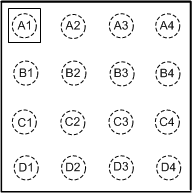SNOSB43C September 2011 – November 2016 LM3560
PRODUCTION DATA.
- 1 Features
- 2 Applications
- 3 Description
- 4 Revision History
- 5 Pin Configuration and Functions
- 6 Specifications
-
7 Detailed Description
- 7.1 Overview
- 7.2 Functional Block Diagram
- 7.3
Feature Description
- 7.3.1 Power Amplifier Synchronization (Tx1)
- 7.3.2 Independent LED Control
- 7.3.3 Hardware Torch
- 7.3.4 Fault Protections
- 7.3.5 Input Voltage Monitor
- 7.3.6 Last Flash Register
- 7.3.7 LED Voltage Monitor
- 7.3.8 ADC Delay
- 7.3.9 Flags Register and Fault Indicators
- 7.4
Device Functional Modes
- 7.4.1 Start-Up (Enabling the Device)
- 7.4.2 Pass Mode
- 7.4.3 Flash Mode
- 7.4.4 Torch Mode
- 7.4.5 Privacy Indicator Mode
- 7.4.6 GPIO1 Mode
- 7.4.7 TX2/INT/GPIO2
- 7.4.8 TX2 Mode
- 7.4.9 GPIO2 Mode
- 7.4.10 Interrupt Output (INT Mode)
- 7.4.11 NTC Mode
- 7.4.12 Alternate External Torch (AET) Mode
- 7.4.13 Automatic Conversion Mode
- 7.4.14 Manual Conversion Mode
- 7.5 I2C-Compatible Interface
- 7.6
Register Descriptions
- 7.6.1 Enable Register (Address 0x10)
- 7.6.2 Privacy Register (Address 0x11)
- 7.6.3 Indicator Register (Address 0x12)
- 7.6.4 Indicator Blinking Register (Address 0x13)
- 7.6.5 Privacy PWM Period Register (Address 0x14)
- 7.6.6 GPIO Register (Address 0x20)
- 7.6.7 LED Forward Voltage ADC (VLED Monitor Register, Address 0x30)
- 7.6.8 ADC Delay Register (Address 0x31)
- 7.6.9 VIN Monitor Register (Address 0x80)
- 7.6.10 Last Flash Register (Address 0x81)
- 7.6.11 Torch Brightness Register Descriptions (Address 0xA0)
- 7.6.12 Flash Brightness Register (Address 0xB0)
- 7.6.13 Flash Duration Register (Address 0xC0)
- 7.6.14 Flags Register (Address 0xD0)
- 7.6.15 Configuration Register 1 (Address 0xE0)
- 7.6.16 Configuration Register 2 (Address 0xF0)
- 8 Application and Implementation
- 9 Power Supply Recommendations
- 10Layout
- 11Device and Documentation Support
- 12Mechanical, Packaging, and Orderable Information
Package Options
Mechanical Data (Package|Pins)
- YZR|16
Thermal pad, mechanical data (Package|Pins)
Orderable Information
5 Pin Configuration and Functions
YZR Package
16-Pin DSBGA
Top View

Pin Functions
| PIN | TYPE | DESCRIPTION | |
|---|---|---|---|
| NO. | NAME | ||
| A1 | LED1 | Power | High-side current source output for flash LED |
| A2, B2 | OUT | Power | Step-up DC-DC converter output. Connect a 10-µF ceramic capacitor between this pin and GND. |
| A3, B3 | SW | Power | Drain connection for internal NMOS and synchronous PMOS switches. |
| A4, B4 | GND | Ground | Ground |
| B1 | LED2 | Output | High-side current source output for flash LED |
| C1 | LEDI/NTC | Power | Configurable as a high-side current source output for indicator LED or comparator input for LED temperature sensing. |
| C2 | TX1/TORCH/ GPIO1 | Input/Output | Configurable as a dual-polarity rf power amplifier synchronization input, an interrupt output, or as a general purpose logic I/O. This pin has an internal 300-kΩ pulldown to GND. |
| C3 | STROBE | Input | Active high hardware flash enable. Drive STROBE high to turn on the flash pulse. This pin has an internal 300-kΩ pulldown to GND. |
| C4 | IN | Power | Input voltage connection. Connect IN to the input supply, and bypass to GND with a minimum 10-µF ceramic capacitor. |
| D1 | TX2/INT/GPIO2 | Input/Output | Configurable as a dual-polarity power amplifier synchronization Input, an Interrupt Output, or as a general purpose logic I/O. This pin has an internal 300-kΩ pulldown to GND. |
| D2 | SDA | Input/Output | Serial data input/output. High impedance in shutdown or in power down. |
| D3 | SCL | Input | Serial clock input. High impedance in shutdown or in power down. |
| D4 | HWEN | Input | Logic high hardware enable. HWEN is a high-impedance input and is normally connected with an external pullup resistor to a logic high voltage. |